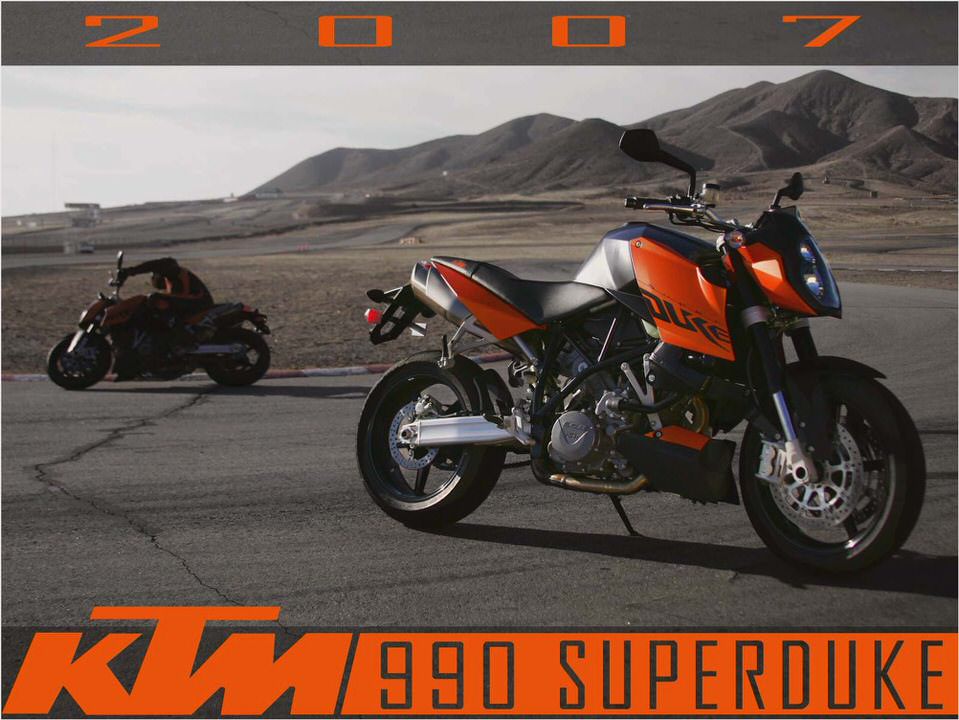
KTM, the Austrian bike manufacturer best known for its fabulous off-road title winning machines, has sets its sights on becoming Europe’s largest motorcycle manufacturer. Although a market leader in the off-road segment it has not up to now had a road bike of any real note, hence the recent launch of the 990 Superduke.
Not backward in coming forward with their intentions, they stated quite clearly at the launch in Fuerteventura, Spain that they intend to conquer the sports orientated street segments. To do this they will launch bikes like the Superduke, defined by their excellent performance to weight ratio and top-notch handling.
While it may seem somewhat boastful, they are far from being the new kids on the block! KTM have been around since 1953 when Messer’s Kronreif and Trunkpolz first opened a small factory in the Upper Austrian village of Mattighofen, which had just 14,000 inhabitants. Taking the first letter of each name and the village formed the brand name.
Two years later they dipped a toe in the water of road racing, but it was to be the world of rough terrain that they were to excel with over ninety world championship titles coming their way over the years.
In 1964 they competed in the International Six days Trial for the first time and ten years later Gennadij Moiseev won their first Motocross World Championship for them. But, despite their continued success, which included an Austrian on an Austrian made bike winning a world championship, seventeen years later they were bankrupt! They immediately reformed a year later in 1992 as KTM Sportmotorcycle-AG under new ownership and management.
The focus was targeted solely on the off-road products and two years later the new company had regained the World MX500 Championship.
In 1998 they opened a new very modern factory in the same Austrian town and by the turn of the new century were dominating off-road sport. But in 2003 they entered the world of road racing for the second time in the 125 GP class and a year later had a win to their credit! When you consider that the firm has just 1500 employees working in the factory this is no mean achievement when compared to the size and financial might of the opposition!
In fact in the year 2003/4 they sold a staggering 78,815 bikes – a rise of 9% over previous figures at a time when other manufacturers are struggling. Therefore, the move to street bikes looks like the result of some good strategic planning!
The Superduke was designed for KTM by Kiska Industrial design in Salzburg, while Phillip Habsburg was in charge of the chassis and overall development in-house. Thomas Rossegger took charge of the engine and Forster Martin, the fuel injection system for the factory.
In appearance the bike displays and aggressive stance that looks like it is ready to take on any bike of whatever genre. The traditional KTM tangerine colour adds to this look, but the black option is slightly more subtle in its approach to the onlooker.
The sharp lines will not appeal to all and tend to polarise peoples views into the love it or hate it camps, but the same is true of many bikes on the market these days. As with most bikes, fashion dictates that the bike has two brushed stainless silencers exiting under the seat. These are fed by a two-in-one exhaust header feeding a three-way catalytic converter.
Sit astride the rather tall bike and you realise the ergonomics have been carefully worked out. Your hands immediately fall onto the new Renthal handlebars of super-strong, tapered aluminium that been especially customized for the Superduke 990. Your legs slot into the sides of the plastic polyamide fuel tank which holds 15-litres of fuel and also contains the fuel pump and pressure regulator. (The tank is cleverly secured in position when it’s tipped upward by suspension rams, for easy access to the engine when it needs servicing.)
The Superduke comes just a year after KTM launched their first twin cylinder motorcycle in the shape of the 950 Adventure, but while based on it, is virtually all-new. They have upped the capacity of the LC8 engine used to power it to form the heart of the 990 Superduke. As you would expect there is marked performance gain that comes from more than just an increase in cubic capacity to 999cc and improved fuel injection and engine management systems.
It is one of the lightest and compact twin-cylinder motors on the market, weighing in at 58kg, or roughly one –third of the bikes overall 179kg dry weight. The weight can be further reduced by a whopping 15kg by making use of the mainly carbon fibre performance parts already on the parts shelves at the factory. Needless to say these are not cheap!
The cylinders have been strengthened to deal with the larger bores which have very light pistons running inside them to help reduce the oscillating mass. The head has been worked on to deal with the 48mm injector bodies and the thicker header pipe on the outlet side as well as a new camshafts. At the bottom end the crankshaft has been changed and a new six-speed transmission has been developed specifically for the street.
The Keihin electronic injection system was tailor-made especially for the KTM 990 Superduke. There are two throttle valves per cylinder in the flow-maximized intake ports. These ensure the perfect mixture preparation and optimum torque progression in every riding situation. Lamba sensors, a catalytic converter and secondary air systems ensure that the bike meets all emissions standards across the world with ease.
Claimed output is 88kw or 120 HP at 9,000rpm with the maximum torque of 100Nm coming at 7,000rpm.
So what about the rest of the bike? The completely new, tubular space frame is similar in appearance to the 950 Adventure’s. However, its geometry, dimensions and tube dimensions were specially designed for the needs of a super-agile, high-performance street bike.
Weighing less than 10 kilograms, its light, chrome-moly construction offers extremely high torsional rigidity that should guarantee safety, even at the highest road speeds. At the back the swing-arm has a length of only 575 mm and is constructed of tapered, extruded aluminium to be very light and rigid in its construction. Opposite this are 48mm WP USD forks that feature adjustable compression and rebound damping, as well as a variable spring preload and give 135-mm of suspension travel.
The 160-mm of suspension movement at the rear is again controlled by a White Power unit. Directly connected to the swing arm, the WP mono-shock features adjustable rebound damping and pressure damping is adjustable for high and low speeds.
Any items not made in-house and bought in are top quality items and there has been no cost cutting, which means that the street price of £8345 is easily justified. KTM own WP, but they do not own Brembo who supply the superb braking set-up. At the rear is a Brembo single-piston, floating brake caliper with a 240 mm brake disc, while at the front are two 320 mm discs gripped by a four-piston fixed-calipers with four individual pads per side!
These are mounted to super-light seventeen-inch cast aluminium wheels developed specifically for the bike by Brembo. The 3.5 and 5.5 rims are shod with sticky Pirelli Diablo tyres.
So on paper the Superduke has all the attributes to be the top dog in the naked ‘Streetfighter’ class that is currently the fastest growing market.
But can it deliver in reality. The answer is a resounding Yes !
You realise the moment you fire it up and it instantly thunders its zest for life straight at your five senses that this far more than an Adventure in street clothes. The sound from the rear is superb and you will not need to change the cans to get a sound as good as a Harley when pottering through town!

Snick silently into first gear and feel the punch from the motor and you just know you are going to have fun. However, after riding it for a while you begin to realise you have been making progress without fuss and drama and not having to think about things. It’s almost a case of the bike reacting to your thoughts, rather than your actions.
The gearbox is one of the smoothest on the market and it never clonks when engaging first gear or misses a change. The new clutch is light in operation and complements it well. Likewise the fuel injection is well matched to the bikes power characteristics. Every little twist of the throttle is immediately turned into forward thrust, whether that be on the open road or around town.
The power is smooth and progressive from just a whiff of throttle and there are no steps or glitches, all of it is useable. It is almost like there is a telepathic connection between the throttle and the rear wheel at times.
Despite its civilised nature, it will provide a challenging ride on the open road and will top 140 mph providing you are hanging on tightly to deal with the wind pressure at these speeds. Take it onto a set of challenging bends such as the coastal and mountain roads that abound on Fuerteventura and you realise why the bike has been built. These are plenty of bikes that can emulate it around town and on the open road, but up the ante and the challenge and the bike really comes into its own.
Bends can be attacked with belief that nothing can challenge the bikes ability to deal with them. Its quick-reacting chassis ensures plenty of safety reserves in combination with the superb braking provided by the Brembo’s. The bike can be thrown into either single bends or a series of
curves and it is always ultra-precise and agile.
When you tweak the fully suspension into the sports mode settings, the bike is almost uncatchable and will leave most sportsbikes as mere dots in its mirrors until the roads open out again. Set up like this it loses some of its comfort for normal riding. but as the changes take seconds, it is no problem. This is actually a bike that you could tour on and then unstrap you luggage at the destination and then tweak the suspension before going out to play!
A tank bag is one of the options already offered by the factory.
Night time use is not a problem as the headlight is good enough to light the way even in the inky blackness of the Canaries, if not good enough to wake up Spanish cab drivers!
As an overall package it is hard to believe that this is the factory’s first attempt at a proper street bike. It is very user friendly in every department, has top notch handling and real world practicality, all wrapped up in a quality package. The only real downside is it small range dictated by the 15-litre tank and its lack of immobiliser as standard.
Although, to be fair, you can purchase a factory alarm that just plugs into the existing wiring as an optional extra. However, those small points aside this is a bike that should tempt you away from the real head-down sports bikes. After all 180+ mph may provide a rush that even this bike cannot, but at a risk that is becoming unacceptable on the road!
Besides this is far more comfortable and a little cheaper.
Its direct competitors are bikes like the MV Brutale, the Ducati S4R Monster, Triumph Speed Triple, Cagiva Raptor, Benelli TNT and the Buell XB12R and it leaves them all trailing in its exhaust gases on the road! However, it lacks the name on the street compared to say MV, but that is surely going to change in a very short time!
So, is KTM’s claim about becoming the leading European motorcycle manufacturer just an arrogant boast or a prophesy of things to come? Well, the history books show the capability has always been there and if the Superduke is anything to go by, I would say the latter option is the choice of the wise!
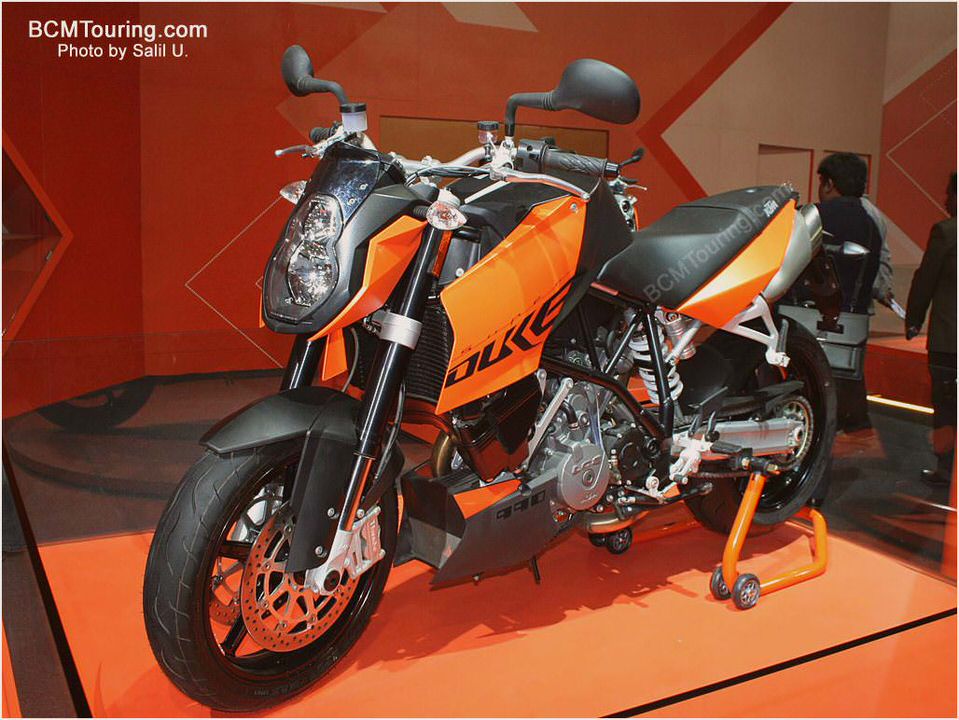
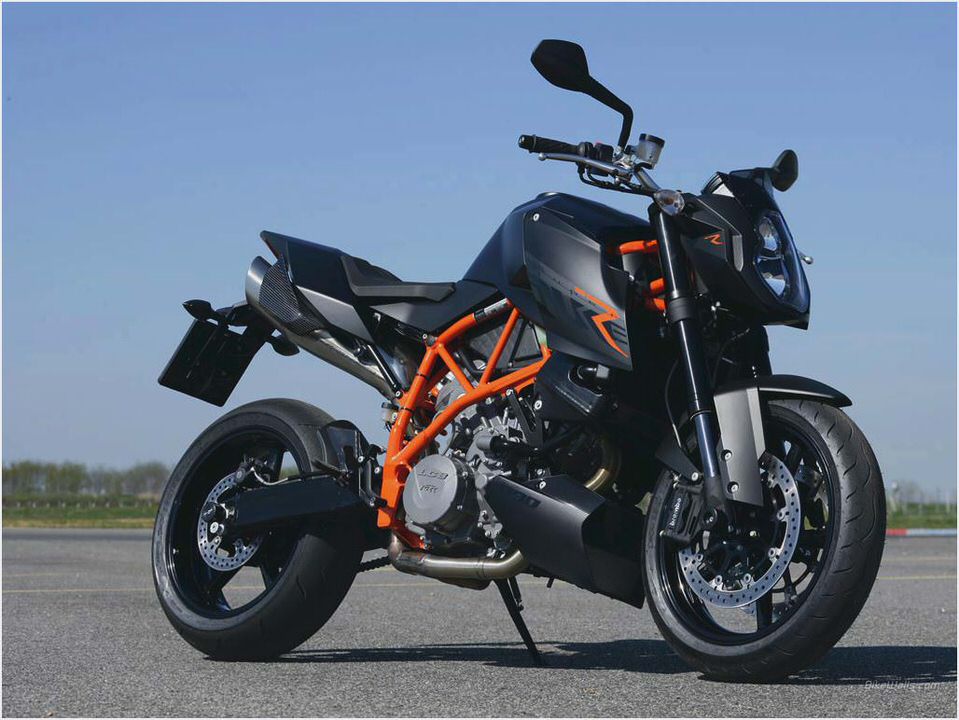
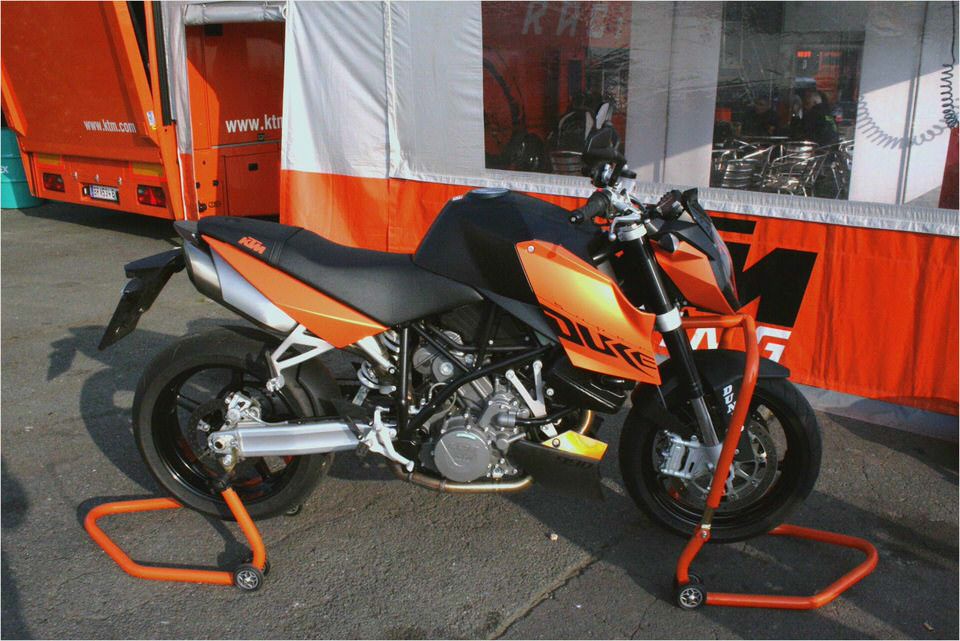
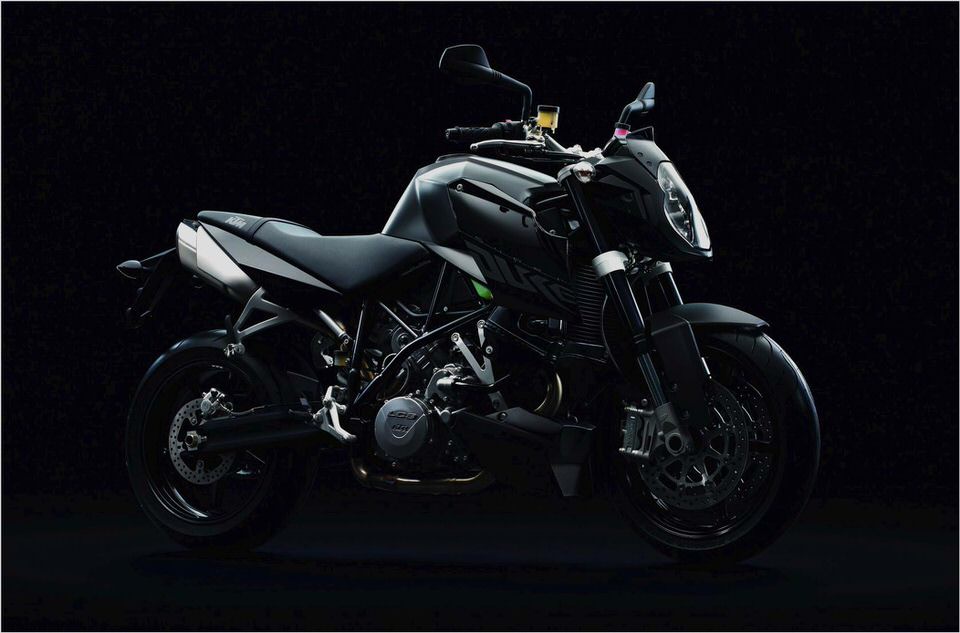
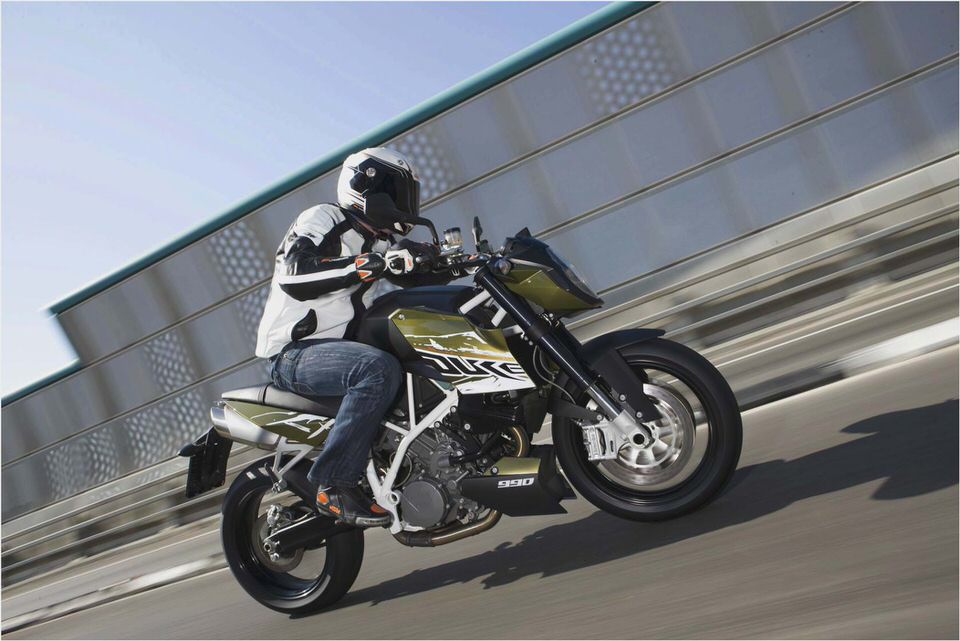
- 2012 KTM 350 SX-F Only Trail Bikes!
- 2006 KTM 625 SMC Walkaround In HD DIY Reviews!
- Review for KTM 990 Adventure, KTM 990 Adventure
- 2009 KTM 450 SX-F motorcycle review @ Top Speed
- KTM 125 Duke (2011) First Look

